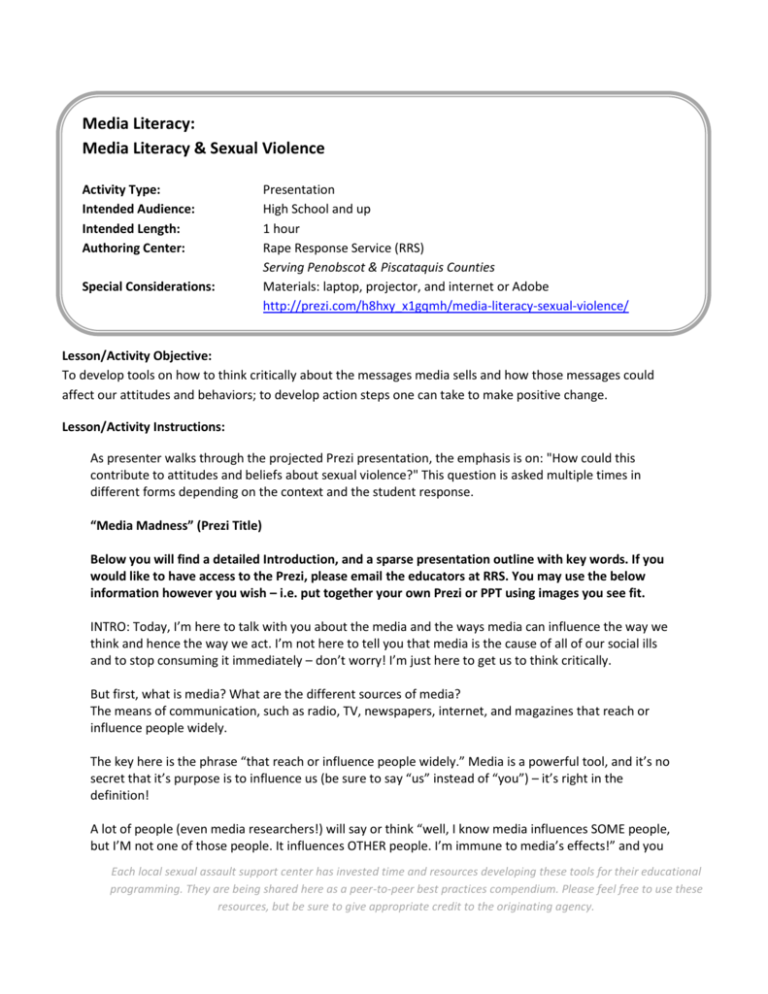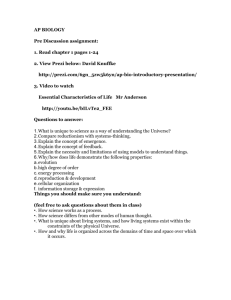
Media Literacy:
Media Literacy & Sexual Violence
Activity Type:
Intended Audience:
Intended Length:
Authoring Center:
Special Considerations:
Presentation
High School and up
1 hour
Rape Response Service (RRS)
Serving Penobscot & Piscataquis Counties
Materials: laptop, projector, and internet or Adobe
http://prezi.com/h8hxy_x1gqmh/media-literacy-sexual-violence/
Lesson/Activity Objective:
To develop tools on how to think critically about the messages media sells and how those messages could
affect our attitudes and behaviors; to develop action steps one can take to make positive change.
Lesson/Activity Instructions:
As presenter walks through the projected Prezi presentation, the emphasis is on: "How could this
contribute to attitudes and beliefs about sexual violence?" This question is asked multiple times in
different forms depending on the context and the student response.
“Media Madness” (Prezi Title)
Below you will find a detailed Introduction, and a sparse presentation outline with key words. If you
would like to have access to the Prezi, please email the educators at RRS. You may use the below
information however you wish – i.e. put together your own Prezi or PPT using images you see fit.
INTRO: Today, I’m here to talk with you about the media and the ways media can influence the way we
think and hence the way we act. I’m not here to tell you that media is the cause of all of our social ills
and to stop consuming it immediately – don’t worry! I’m just here to get us to think critically.
But first, what is media? What are the different sources of media?
The means of communication, such as radio, TV, newspapers, internet, and magazines that reach or
influence people widely.
The key here is the phrase “that reach or influence people widely.” Media is a powerful tool, and it’s no
secret that it’s purpose is to influence us (be sure to say “us” instead of “you”) – it’s right in the
definition!
A lot of people (even media researchers!) will say or think “well, I know media influences SOME people,
but I’M not one of those people. It influences OTHER people. I’m immune to media’s effects!” and you
Each local sexual assault support center has invested time and resources developing these tools for their educational
programming. They are being shared here as a peer-to-peer best practices compendium. Please feel free to use these
resources, but be sure to give appropriate credit to the originating agency.
might be one of those people. Today, I want to encourage you to think about ways in which you might
actually be affected by media.
So what we’re talking about here is Media Literacy! What does literacy mean?
Here, media literacy means “the ability to think critically about the messages media sells”.
So again, I’m not here to tell you media is the cause of life’s problems, but I am here to talk about why
it’s important to think critically about how media might be affecting your thoughts and maybe even your
behaviors or actions.
I.
How are women portrayed in the media? (** note, I recommend using one image per word,
otherwise it’s just picture overload).
a. Weak and Stupid
b. Dismembered – just body parts!
c. Objectified & Sexual Accessories (there is a “lynx body wash” ad with a woman covered
in mud with “wash me” written across her stomach (looks like something you would see
on a car. Also, Tom Ford cologne ads show women looking like blow up dolls with the
perfume between their breasts of covering their pubic area).
d. On Display – great place to discuss Street Harassment
e. Pieces of meat
f. Submissive – where, when, and how do girls learn to say no? Do they learn at all? Or is it
all about being nurturing and putting others before yourself?
g. Hypersexual – they don’t own their own sexuality, they are hypersexual for men (note
the heteronormative nature of media)
II. How are men portrayed in the media?
a. Strong & Proud
b. Hypersexual – they own their sexuality and their sexual desires and act on them for their
own pleasure.
c. Dominant – (Dolce and Gabbana ads are great for illustrating this point) – either
physically dominant or dominating the political/economic/business/etc sphere.
d. Violence as sexy – (Calivin Klein ads are great for this one)
e. Angry
f. Sexual Predators – If you are a guy, imagine you and your friends are walking down the
street, and you notice a woman walking by herself. She reaches for her purse, looks
stone-faced at you guys, and crosses the street. How do you feel knowing you just made
her uncomfortable just by existing? Bad? Time to change these norms.
i. Also a good place to discuss rape jokes – i.e. Family Guy & Quagmire the “funny”
sexual predator.
g. One Track Mind: Sex. And you get sex by having money and/or power. What are the
ways this could harm men and women?
III. Statistics:
(a-d taken from: APA Task Force on Sexualization of Young Girls, 2010 -http://www.apa.org/pi/women/programs/girls/report.aspx)
Each local sexual assault support center has invested time and resources developing these tools for their educational
programming. They are being shared here as a peer-to-peer best practices compendium. Please feel free to use these
resources, but be sure to give appropriate credit to the originating agency.
a. The average young TV viewer will see about 14,000 references to sex each year.
b. Acts of violence and explicit sex on TV are so common, we begin to think of aggression
and violence as normal and acceptable… even wanted.
c. There’s been a 400% increase in the depiction of teen girls as victims across all TV
networks from 2004-2009.
d. Young people spend more time with entertainment media than they do with any other
activity other than school and sleeping.
e. Other stats you think are appropriate
IV. What can YOU do to help a friend?
a. Believe them
b. Encourage their choices
c. Support them
d. Offer RRS services
V. What can YOU do in your own community?
a. Bystander Intervention: Tools and language for success
Each local sexual assault support center has invested time and resources developing these tools for their educational
programming. They are being shared here as a peer-to-peer best practices compendium. Please feel free to use these
resources, but be sure to give appropriate credit to the originating agency.








